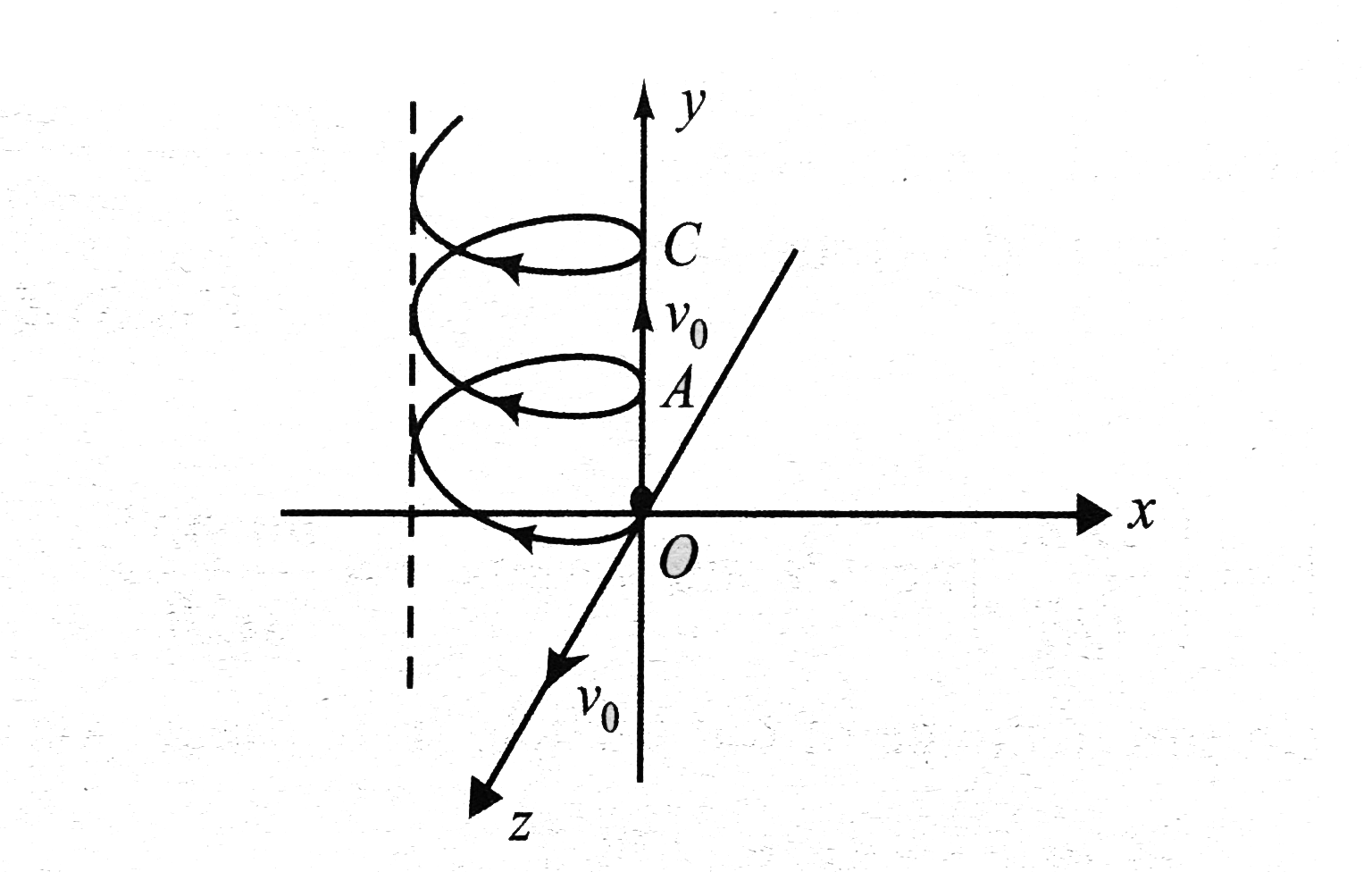A proton is fired from origin with velocity →v=v0ˆj+v0ˆk in a uniform magnetic field →B=B0ˆj.
its z-coordinate can never be negative
its x-coordinate can never be negative
its x-and z-coordinates cannot be zero at the same time
its y-coordinate will be proportional to its time of flight
The correct Answer is:(b,d)
The path of the particle will be helix as shown in fig. Clearly
x-coordinate is always negative. z-coordinate can be negative
and positive both. X and z coordinate will be zero at the same
time at points A, C etc
y=v0t⇒y∝t

Topper's Solved these Questions
- MAGNETIC FIELD AND MAGNETIC FORCESBook:CENGAGE PHYSICSChapter:MAGNETIC FIELD AND MAGNETIC FORCESExercise:Exercises Assertion -reasoning
Explore 8 Videos
- MAGNETIC FIELD AND MAGNETIC FORCESBook:CENGAGE PHYSICSChapter:MAGNETIC FIELD AND MAGNETIC FORCESExercise:Exercises Linked Comprehension
Explore 28 Videos
- MAGNETIC FIELD AND MAGNETIC FORCESBook:CENGAGE PHYSICSChapter:MAGNETIC FIELD AND MAGNETIC FORCESExercise:Exercises Single Correct
Explore 70 Videos
- KINETIC THEORYBook:CENGAGE PHYSICSChapter:KINETIC THEORYExercise:Question Bank
Explore 31 Videos
- Magnetism and MatterBook:CENGAGE PHYSICSChapter:Magnetism and MatterExercise:Question Bank
Explore 50 Videos
Similar Questions
A particle of specific charge α is projected from origin with velocity v=v0ˆi−v0ˆk in a uniform magnetic field B=−B0ˆk. Find time dependence of velocity and position of the particle.
View SolutionA charged particle (q.m) released from origin with velocity v=v0ˆi in a uniform magnetic field B=B02ˆi+√3B02ˆJ.
Z-component of velocity is √3v02 after in t=……….
View Solution
Knowledge Check
A portion is fired from origin with velocity →v=v0ˆj+v0ˆk in a uniform magnetic field →B=B0ˆj. In the subsequent motion of the proton
Aits z co-ordinate can never be negativeBits x co-ordinate can never be positiveCits x and z co-oridinate cannot be zero at the same timeDits y co-ordinate will be proportional to its time of flightA particle of charge per unit mass α is released from origin with a velocity →v=v0ˆi uniform magnetic field →B=−B0ˆk. If the particle passes through (0,y,0), then y is equal to
A−2v0B0αBv0B0αC2v0B0αD−v0B0αA charged particle of specific charge (charge/mass) α released from origin at time t=0 with velocity →v=v0(ˆi+ˆj) in uniform magnetic field →B=B0ˆi. Coordinates of the particle at time t=π/(B0α) are
A(v02B0α,√2v0αB0,−v0B0α)B(v02B0α,0,0)C(0,2v0B0α,v0π2B0α)D(v0πB0α,0,−2v0B0α)
A charged particle (q.m) released from origin with velocity v=v0ˆi in a uniform magnetic field B=B02ˆi+√3B02ˆJ.
When z-co-ordinate has its maximum value
View SolutionA charged particle (q.m) released from origin with velocity v=v0ˆi in a uniform magnetic field B=B02ˆi+√3B02ˆJ.
Pitch of the helical path described by the particle is
View SolutionA charged particle (q.m) released from origin with velocity v=v0ˆi in a uniform magnetic field B=B02ˆi+√3B02ˆJ.
Maximum z-coordinate of the particle is
View SolutionA charge praticule of sepeific charge (charge/ mass ) α is realsed from origin at time t=0 with velocity v=v0(ˆi+ˆj) in unifrom magnetic fields B=B0ˆi. Co-ordinaties of the particle at time t=πB0α are
View SolutionA particle of charge per unit mass α is released from origin with a velocity →v=v0ˆi in a magnetic field
→B=−B0ˆk for x≤√32v0B0α
and →B=0 for x>√32v0B0α
The x-coordinate of the particle at time t(π3B0α) would be
View Solution